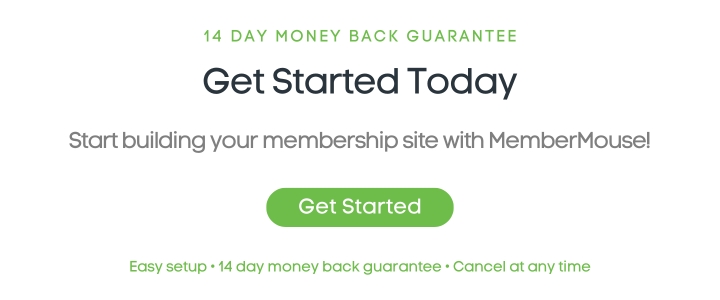How to Sell Videos Online (In 8 Simple Steps)
Videos provide an excellent way to diversify your content and appeal to a wider variety of people. Tapping into this popular content format can help you build your audience, establish meaningful relationships, and set up recurring revenue. However, without the appropriate technical skills, you might not know how to sell videos online.
Fortunately, if you're using WordPress, it’s relatively simple. Once you’ve selected a niche and a video hosting platform, you can build a unique video website. Then, you’re able to monetize your videos by protecting your content with membership rules.
In this post, we’ll take a closer look at why to sell videos online. Then, we’ll guide you through eight steps to start selling your videos today. Let’s get started!
Why to Sell Videos Online
Watching videos over the internet is one of the most popular activities for digital audiences across the globe. As such, it's become a daily part of life for online users, arguably replacing traditional television viewing.
For example, the number of Netflix subscribers worldwide has increased to nearly 283 million in the third quarter of 2023. Meanwhile, In 2024, TikTok, estimated to reach two billion users, has reached 90% of internet users in some Asian countries as of July 2024.
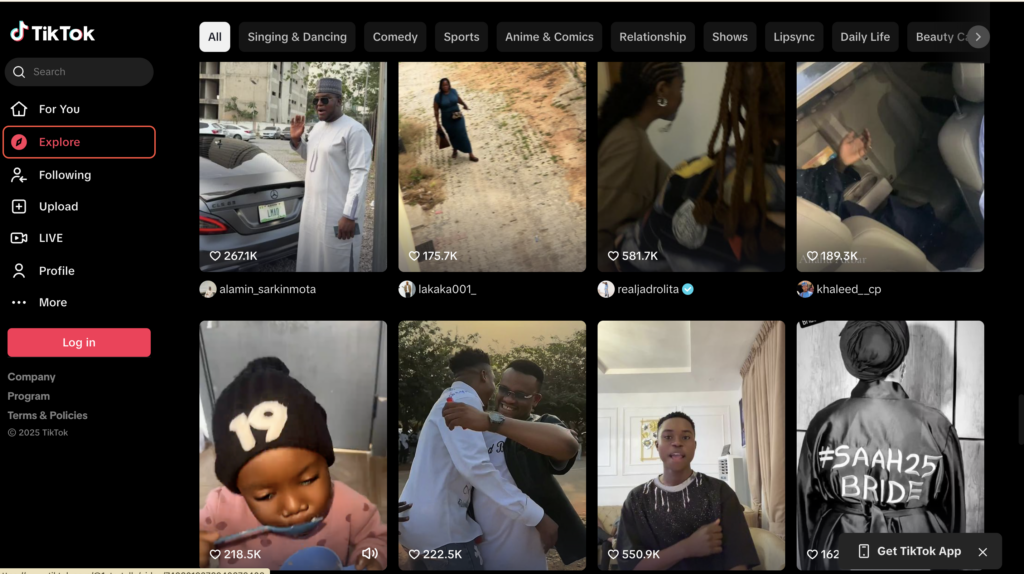
Meanwhile, YouTube has 2.5 billion users worldwide with 240 million US users and 476 million Indian users. Essentially, online videos can give you access to a huge audience.
Additionally, since videos enable people to see your face and hear your voice, they can lead to more meaningful relationships with your audience. This can establish customer loyalty, which is useful if you plan on selling your own products (or even affiliate products).
There are also a number of ways to use this online format. You might prefer chatty vlog-style videos or Q&As. Alternatively, you can create product reviews or in-depth tutorials. Better yet, videos tend to increase engagement since it's easy for visitors to like and share the content.
Lastly, online videos are a great way to monetize your website and set up a recurring revenue stream. You can charge one-time fees for general visitors. Or, you can create memberships and make your video library accessible to paying members.
How to Sell Videos Online (In 8 Steps)
Now that you know why it's a good idea to sell videos online, here are eight steps to do it.
1. Choose a Specific Niche
The first step to sell videos online is to choose a specific niche. While you might want to focus on a general topic like health and fitness, you can hone in on a more narrow subject based on your ideal customer (or a sub-topic within the niche).
For example, The Mother Runners provides free and premium coaching to moms trying to stay fit while managing family responsibilities:

While this may reduce the size of your audience, you can end up building a more loyal following, which can be highly effective if you're looking to monetize your website.
Additionally, a specific niche enables you to differentiate your content from others in the industry. This is especially true for very saturated niches like travel, food, or fashion.
If you're not sure how to choose a niche for your online videos, it's best to check out existing video content via sites and apps like YouTube and TikTok. It's also a good idea to surf the internet more generally to find niche ideas to inspire you.
What's more, it's useful to conduct some market research before you settle on a niche. To do this, you can post simple questions or entire surveys in forums, communities, or groups (like Facebook and LinkedIn). Meanwhile, a SWOT analysis can help you identify the strengths and weaknesses of your project.
2. Create a Content Strategy
If you're going to sell videos online, it's a good idea to create a content strategy to determine the structure of your videos. Plus, this enables you to define the frequency in which you'll post, so you'll know how to plan and prepare for your videos way ahead of time.
To get started, it helps to have a solid understanding of your audience. You can ask yourself some basic questions, like the following:
- What would viewers want to achieve by watching my videos?
- How much time do followers have to engage with my content?
- What age group do I want to appeal to?
With this in mind, short videos are preferred by Gen Z and Millenials when it comes to learning about products and their features. 47% of video marketers also say short videos are more likely to go viral.
Once you've determined your optimal video duration, it's time to consider the structure of your content. Do you want to film product tutorials to show visitors how to use your items? Will you feature guests or co-hosts to engage in interviews or Q&As?
Lastly, it's important to decide on a posting schedule so that your visitors know when to expect new content. It's best to create a content calendar that you can realistically stick to. Therefore, you might begin with one video a week. Then, if you find you're able to increase your output, you can do so.
The final consideration is whether or not you'll include any supplementary content. For instance, if you create fitness videos, you might put together a PDF guide that users can download. Or, if you're selling online courses, it can help to give members access to other resources like documents or infographics.
3. Find a Video Hosting Platform
Now that you've decided on a content strategy, you'll need to choose a video hosting platform. If you want a free solution, YouTube is an excellent option.
With over 2.5 billion users worldwide, YouTube gives you access to a huge community to share your videos. Plus, it's relatively straightforward to create a YouTube account and increase your visibility using Search Engine Optimization (SEO)
There are also no limits on bandwidth and storage. Meanwhile, it's easy to embed videos on your website using URLs. However, while you can keep a portion of the ad revenue, there is no way to disable advertisements. Therefore, ads will play automatically even on videos embedded on your site.
Unlike YouTube (which is a social sharing platform), Vimeo offers a dedicated video hosting platform for professionals and creatives:
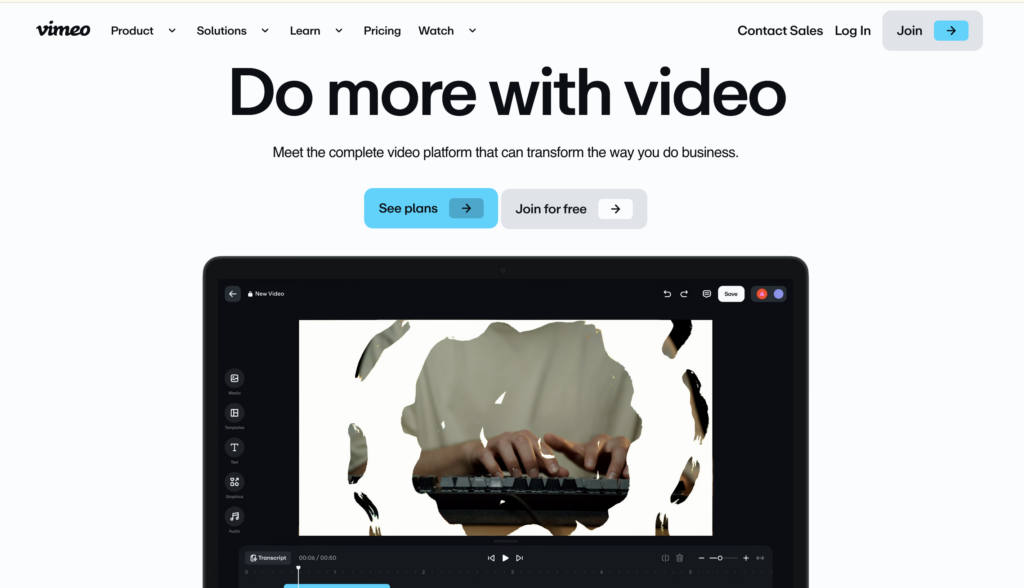
Therefore, it tends to be best for music videos, animations, nature videos and images, and original short films.
One of the best features of Vimeo is that there are no ads. Plus, you can create an account for free and enable direct video downloads. Alternatively, you're able to embed Vimeo content discreetly on your website.
If you have a larger budget, Wistia might be a good fit for your online videos. While Wistia offers a free plan, you'll be limited to ten videos, so if you plan on creating videos regularly, you'll need to upgrade to a premium package.
Like the other options, you can use the platform to upload and embed videos on your website. However, Wistia also offers advanced features to help market your videos.
For example, you can embed lead capture forms and even feature calls to action (CTAs) in the video player. And like Vimeo, you won't have to place ads in your content.
4. Consider How You'll Monetize Your Videos
With your video platform in place, it's time to decide how you'll make money from your online videos. It's important to consider what type of video hosting you've selected and whether it lends itself to your preferred monetization method.
Typically, there are three main ways to earn revenue on digital content. Here are the options:
- Subscription video-on-demand (SVOD). Popular streaming services like Netflix and Amazon Prime use the SVOD model. It gives subscribers access to a library of videos in exchange for a monthly (or annual) membership fee.
- Transactional video-on-demand (TVOD). This monetization strategy enables customers to make one-time purchases to access a specific video. In that way, it's similar to buying a movie on iTunes.
- Advertising video-on-demand (AVOD). If you don't want to charge your viewers, you can use the AVOD model. Instead, you'll generate revenue from advertisements like YouTube.
Naturally, you may find yourself restricted by your video hosting platform. As we discussed, YouTube requires you to play ads and there's no option to disable it.
Meanwhile, YouTube and Vimeo have options to create subscriptions. But, if you opt for Wistia, you'll need a third-party tool to control access and payments.
5. Produce High-Quality Videos
If you're going to expect people to pay to watch your content, it's important to produce high-quality videos. If you have the technical skills, you can create video material yourself.
You can even start off using the camera on your smartphone. Eventually, you might level up to a 4K resolution camera since this can capture sharper images thanks to the extra pixels.
Additionally, if you're including sound in your videos, you might consider using an external microphone. In particular, a condenser mic is a great option if you're recording indoors since it will result in crisper audio.
If you feel comfortable shooting videos, but you don't have the expertise or time to edit, you might outsource this task to freelancers. You can find tons of freelancers on sites like Upwork and Fiverr:

You can even find freelancers that cater to your exact video type including YouTube videos, Instagram videos, or gaming videos. Since the services differ quite drastically, you can find options below $20, while more experienced producers charge hundreds of dollars.
However, if you don't have the skills or time to even shoot your videos, you might decide to hire a production team. While this can be expensive, you'll gain invaluable experience. Plus, the team will handle everything for you from lighting and audio to editing and after-effects.
6. Build a Website for Your Videos
The next step to selling videos online is to create a beautiful website where visitors can view your video collection. A video website also acts as the ideal platform for monetizing your videos with memberships.
To get started, you'll need a content management system (CMS) to upload and organize your videos. WordPress is an excellent option since it's free and open-source.
Plus, when you choose this method, you'll own all your content, which can't be said for some alternatives. To make your website publicly accessible, you'll need to choose a domain name and a web hosting provider to store your files and database.
WordPress is a fully customizable platform so you can achieve a totally unique website that reflects your brand. To change the look and feel of your site, you can install a WordPress theme straight from your dashboard:

Meanwhile, plugins enable you to expand the functionality of your site. For instance, if you want to build subscriber forms and contact forms, you can use a plugin like WPForms.
Now, you can either upload videos to the Media Library or embed videos on certain pages. This makes it easier to protect your videos behind membership rules (which we'll discuss in the next section).
To embed a video in WordPress, open the page or post where you want to feature it. If you're using the Block Editor, you can find dedicated YouTube and Vimeo blocks.
Or, simply add a Video block to your page. You can then upload a video from your computer or the Media Library. Or click on Insert from URL:
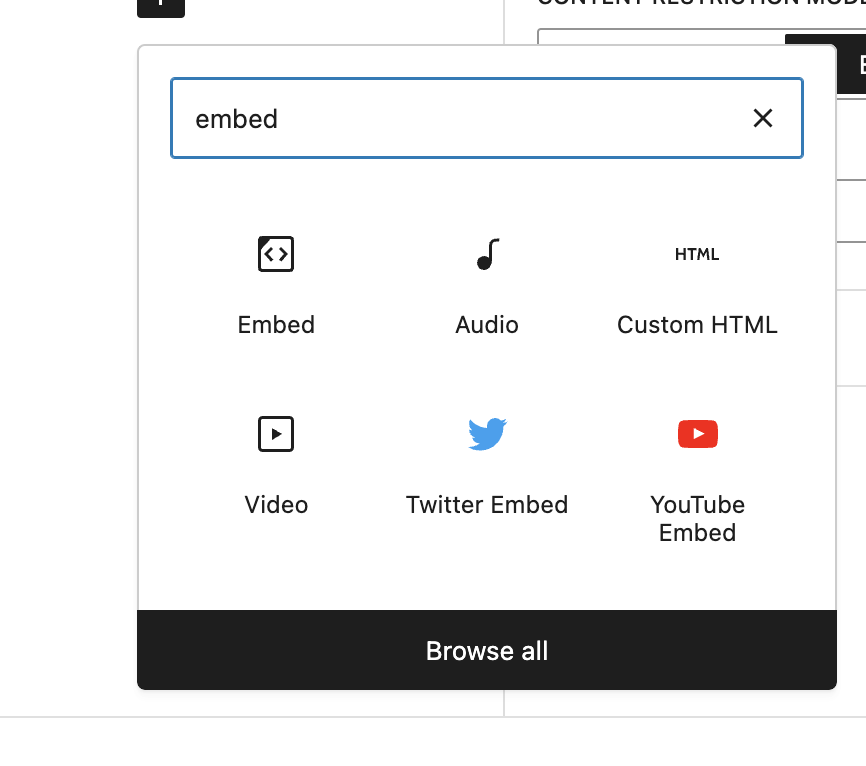
Your video should be displayed immediately in the editor.
Save the page. Repeat the process if you want to create more video pages.
7. Protect Your Videos with Membership Rules
Now, if you want to monetize your videos using subscriptions, you'll need to protect your videos with membership rules. Therefore, you'll need to install a membership plugin like MemberMouse:
MemberMouse enables you to protect any pages and posts on your website, so you can easily protect pages with videos or any other kind of content you can imagine. Better yet, you can configure free and paid membership options which you'll manage through a stylish dashboard. And, you can even facilitate one-time purchases for non-members.
You'll need to purchase a plan from the MemberMouse website. Then, in your WordPress dashboard, go to Plugins > Add New > Upload. Here, upload your zip file. Then, click on Install Now > Activate Plugin:
If you want to create paid memberships, you'll first need to add your membership as a product. So, go to MemberMouse > Product Settings > Create Product:
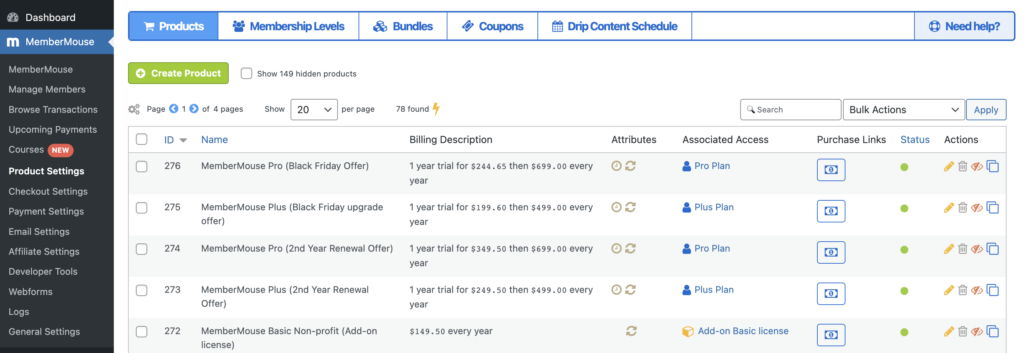
Here, you can set membership prices, subscription periods, and free trials.
Then, switch to Membership Levels and click on Create Membership Level. Now, you can give your membership a name and customize the welcome email.
Then, under Membership Type, select Paid and find the product you added earlier:
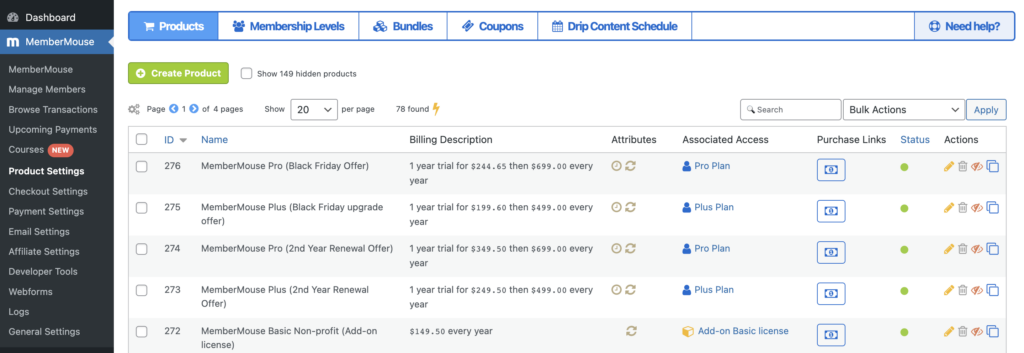
Now, open the page or post that contains your video. In the Post settings, you'll see MemberMouse Options. Here, click on Grant Access. Then, select your membership level.
Or, if you want to protect existing video pages, check the boxes next to relevant pages on the All Pages screen. Then, use the Bulk actions dropdown to select Manage Access and click on Apply.
Here, use the dropdown menu to choose the appropriate membership level and click on Add Access Rights.
8. Promote Your Video Website
Once you have your video website all set up with membership plans, it's time to promote your website to attract more visitors. One of the easiest ways to do this is to offer some of your content for free.
While you can do this through free memberships, you can also create a YouTube channel. For instance, if you're selling an online course, you might make the first lesson publicly available:
Then, you can add links to your website in the description box for viewers who want to continue the course (which will require one of your premium memberships).
Social media offers another great platform to grow your membership site. You can create posts that advertise the video. Or, you might ask existing members to share testimonials with links to your website.
Alternatively, you can build simple subscription forms for your site. Then, you can use the power of email marketing to engage with your members. SEO is also a great way to drive organic traffic to your pages. This can boost your search rankings to make you more visible on the results pages.
Conclusion
If you want to access a global audience and generate a passive income, it’s a great idea to sell videos online. Better yet, it enables you to build deeper relationships with your followers and diversify your content.
To recap, here are eight steps to sell videos online:
- Choose a specific niche.
- Create a content strategy.
- Find a video hosting platform.
- Consider how you'll monetize your videos.
- Produce high-quality videos.
- Build a website for your videos.
- Protect your videos with membership rules.
- Promote your video website.
Do you have any questions about how to sell videos online? Let us know in the comments section below!
If you liked this article, be sure to follow us on Facebook, Twitter, Pinterest, and LinkedIn! And don't forget to subscribe in the box below.
Sarah Olaleye
Sarah is passionate about simplifying the technical nitty-grittys of websites, plugins, and digital marketing. As a content writer at MemberMouse, she has a keen eye for crafting engaging and informative content. Sarah plays a crucial role in educating and empowering users on the full potential of MemberMouse plugins. Bringing a blend of technical knowledge and creative flair, she ensures that each piece of content not only informs but also inspires. When not writing, she enjoys exploring the latest trends in technology and digital marketing, always seeking new ways to enhance the user experience.
 Blog
Blog Podcast
Podcast Support
Support Customer Login
Customer Login

